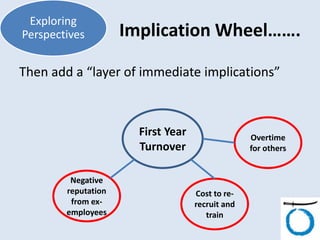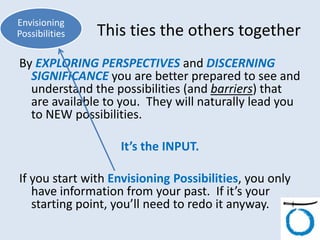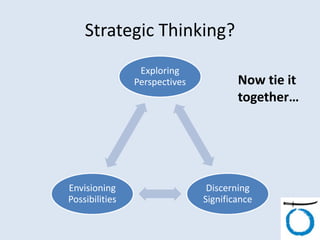Strategic Thinking
- 1. Strategic Thinking: Bringing Perspective to your Daily Routine Kris Mailepors, MBA kris@bushidoleadership.com tw: @bushidoleader
- 2. Strategic Thinking? http://prezi.com/p9f9i5klcrhz/strategic-thinking/ • Develop 3-Dimensional thinking to improve your grasp of problems and opportunities • Identify changes and issues through the lens of their many implications • Have conversations with peers, direct reports, and leaders that are more strategic • Improve your own Decision making
- 3. Strategic Thinking? Directly & Indirectly involving OTHERS in decisions Exploring Perspectives Discerning Significance Envisioning Possibilities
- 4. Learn to think about decisions in three dimensions: 1.Level 2.Position 3.Time Exploring Perspectives
- 5. 1. Level; step back or hone in?Exploring Perspectives Bird’s eye view Treetop view Ground View
- 6. 2. Position; different perspective from the same level Exploring Perspectives Who are your stakeholders? Have you asked them “How do YOU see it?” “What are your thoughts?” “What do YOU think we should do?” This can take COURAGE: you are bucking the idea of doing it NOW and you may give the impression that you are not in total control or know what you are doing.
- 7. 3. Time; consider past, present & future circumstances Exploring Perspectives
- 8. Important tool Implication wheel: a way to anticipate the effects that a problem or issue can have on your or your team Put the issue in the center Exploring Perspectives First Year Turnover
- 9. Implication Wheel……. Then add a “layer of immediate implications” Exploring Perspectives First Year Turnover Overtime for others Cost to re- recruit and train Negative reputation from ex- employees
- 10. Implication Wheel……. Then add a another Layer for each new circle… Exploring Perspectives First Year Turnover Overtime for others Cost to re- recruit and train Negative reputation from ex- employees
- 11. Implication Wheel……. Then add a another Layer for each new circle… Exploring Perspectives Cost to re- recruit and train Money for advertising budget Barrier to development
- 12. Implication Wheel……. This is a tool to get to what we talked about Is the issue the real problem, or a symptom of the problem You try it—here’s the issue Eliminate Employee Shuttle Bus to Save $$ (or pick one) Exploring Perspectives
- 14. What does it mean? 1. Validate info: is the information we are considering accurate/logical/sound? 2. Understand context and system: is this information connected to larger issues or other departments? 3. Clarify what has been learned: what are the main things we have learned relative to our issue? Discerning Significance
- 15. Revisit “Level” Bird’s eye view: Systemic/Big Picture. e.g. Stress Treetop view: Patterns of behavior e.g. Low morale and dysfunction Ground View: Events e.g. Eye rolling, sassing Discerning Significance
- 16. Is everything important? What is a Blip, Fad, Trend, Cycle? • Low interest rates • Women control 80% of household spending • Oxygen Bars/Cigar Bars • New EPA regulation that will Paper companies $200million in 2013? • Any fashion popular with young woman • Obesity in America Discerning Significance
- 18. This ties the others together By EXPLORING PERSPECTIVES and DISCERNING SIGNIFICANCE you are better prepared to see and understand the possibilities (and barriers) that are available to you. They will naturally lead you to NEW possibilities. It’s the INPUT. If you start with Envisioning Possibilities, you only have information from your past. If it’s your starting point, you’ll need to redo it anyway. Envisioning Possibilities
- 19. Strategic Thinking? Exploring Perspectives Discerning Significance Envisioning Possibilities Now tie it together…
- 20. Strategic Thinking? Make an offer they can’t refuse: Six parts to a proposal that works 1. Background 2. Current State 3. Costs (what it IS costing now) 4. Future State 5. Benefits of the change 6. First steps
- 21. Strategic Thinking? Transfer your learning: 1. What is one tool I wish I had and how would it have helped? 2. I plan to start doing __________ from now on. 3. I will be more careful to not do ____________ in the future.





















